The Ice Boxes Market is estimated to be valued at USD 5.7 billion in 2025 and is projected to reach USD 9.4 billion by 2035, registering a compound annual growth rate (CAGR) of 5.1% over the forecast period.

The ice boxes market is experiencing steady growth, underpinned by rising consumer demand for outdoor recreational activities, increased disposable income, and greater awareness of perishable goods preservation. The resurgence of interest in camping, tailgating, and beach travel is expanding the addressable market, while growing emphasis on portable, durable, and temperature-retaining storage solutions has driven innovation in product design.
Enhanced insulation technologies and the integration of lightweight, rugged materials have supported product longevity and ease of transport. Manufacturers are prioritizing user-centric features such as ergonomic handles, wheels, and quick-access lids, tailored to evolving consumer expectations for convenience and efficiency.
Environmental considerations are also influencing product design, with a push toward recyclable components and energy-efficient manufacturing. Looking forward, the market is anticipated to benefit from expanding e-commerce penetration, seasonal demand trends, and ongoing product diversification aimed at both premium and mass-market segments.
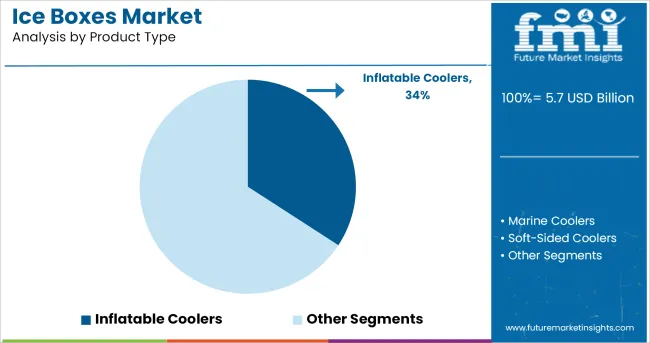
The inflatable coolers segment is anticipated to contribute 34.20% of the total product type revenue by 2025, positioning it as the leading format. This dominance is attributed to their portability, compact storage capability, and ease of use, which align well with casual, on-the-go consumers.
Their lightweight design allows for effortless transportation and quick deployment, making them ideal for short-duration outdoor activities. Advancements in air-sealed materials and puncture-resistant coatings have improved durability and thermal retention, supporting broader usage across recreational settings.
Additionally, lower production costs and attractive price points have facilitated widespread market access. As a result, inflatable coolers have gained prominence by addressing the balance between convenience, affordability, and functionality in ice box applications.
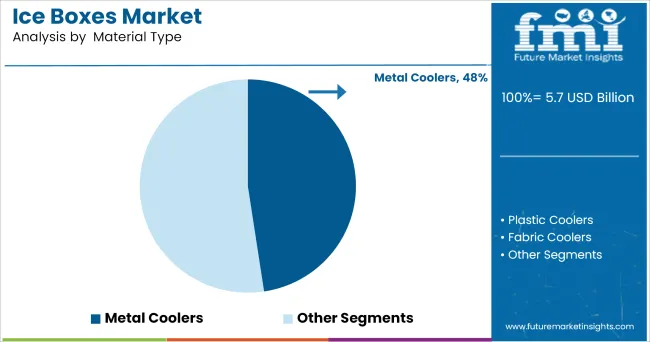
Metal coolers are expected to account for 47.60% of revenue within the material type category, making them the dominant material selection. Their leadership is driven by superior thermal insulation, structural durability, and a high-end aesthetic that appeals to premium outdoor and lifestyle consumers.
The use of rust-resistant aluminum and stainless steel has enhanced product lifespan, while integration of modern design elements has improved visual appeal and brand perception. Metal coolers are increasingly preferred in rugged environments due to their resistance to impact and deformation.
Moreover, their association with long-term value and brand reliability has fostered consumer trust, particularly among serious outdoor enthusiasts. These advantages have positioned metal coolers as the top choice for consumers seeking performance, longevity, and upscale design.
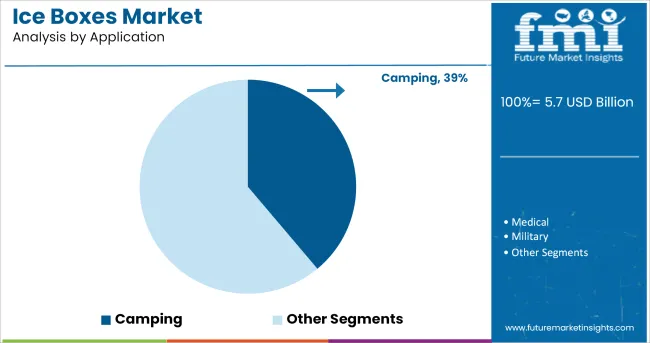
The camping application segment is projected to generate 38.90% of the overall market revenue by 2025, establishing it as the foremost use case for ice boxes. This share is supported by the rising popularity of nature tourism, extended outdoor stays, and adventure travel across global markets.
Ice boxes serve as an essential utility for preserving food and beverages in remote locations without electricity, contributing to their indispensability among campers. Product features such as multi-day ice retention, bear-resistant certification, and storage versatility have made ice boxes a staple within this category.
Furthermore, growth in camping gear rental services and outdoor-focused retail channels has expanded product accessibility. As the culture of outdoor living continues to flourish, demand for reliable, rugged, and thermally efficient ice storage solutions will remain anchored to the camping segment, reinforcing its leadership in the application category.
In the times when people avoid eating and drinking outside, ice boxes prove to be a perfect solutions to all their woes and helps them carry their favorite food products or drink without hampering its quality.
Ice boxes are commonly used in those areas which reports higher level of temperature. As the population of outdoor recreational activities has gone upwards, the number of ice boxes manufacturers in the markets has also witnessing a spike.
Further, ice boxes are made out of plastics majorly, these boxes are ultra-light in weight and arrives in various sizes. Meanwhile the ice boxes that are disposable in nature are made of polystyrene foam. Several initiatives from the most of the federal governments to promote outdoor activities is also likely to provide impetus to the growth of the ice boxes market.
Moreover, countries like India, Brazil, and china are expected to contribute to the growth of the ice boxes market. The governments in these countries is providing a stimulus for the development of healthcare, food & beverages and chemical market, and this ultimately aids the ice boxes market grow.
Availability of labor and raw material at a lower costs and favorable foreign direct investment (FDI) in these countries is luring numerous ice boxes manufacturers.
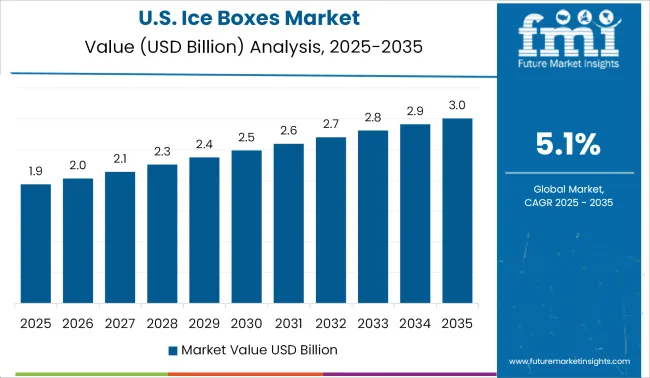
The Countries like USA and Canada has the highest revenue share in the ice boxes market. This is mainly because of intersecting trends of these countries’ surging adoption rate of new technology and relatively hot weather conditions. Along with this the population in this region is more interested in outdoor camping and sports recreations culture, and this is pushing industry giants to invest more.
Adding to this, key manufacturers in the USA market are investing heavily in research & development activities to offer enhanced customer experience and reduce operating costs. Further, rising interest in minibars among working-class professionals is expected to promote the scope for ice boxes in the USA market.
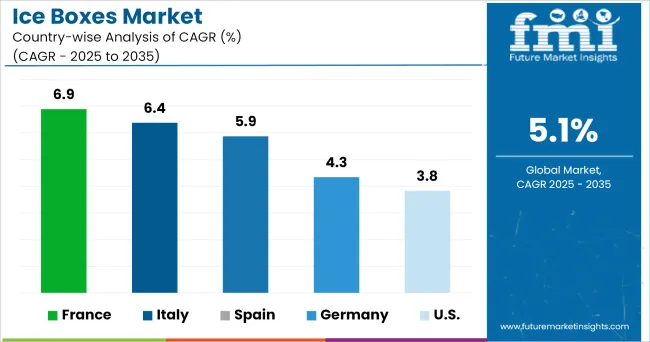
The European nationals like Italy and Spain are forecasted to witness a massive surge in the demand for ice boxes, mainly because of increasing interest in outdoor activities and higher income amount of population in this region.
These countries are also hub of tourism and lure significant number of international travelers each year. The presence of major ice box manufacturers in the region showcase the increased demand.
Moreover, governments are coming up with new policies in order to minimize the energy consumption of appliances. The policies support the consumption and manufacturing of energy-efficient electronic appliances and provide ease in contributing to environmental sustainability.
This in turn will fuel the consumption of energy-efficient cold storage devices. Additionally, incentive schemes such as discounts, vouchers and coupons provided by the companies will attract customers towards ice boxes and help in the market growth.
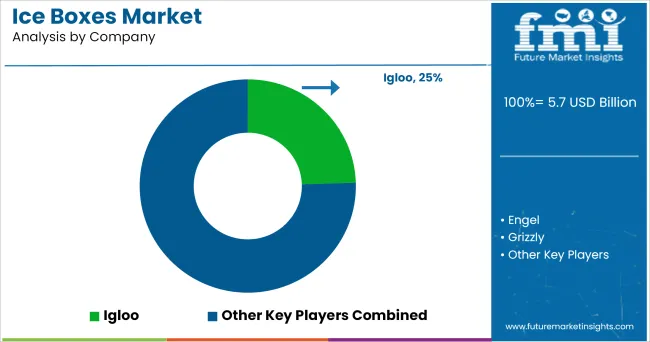
Some of the leading manufacturers of Ice Boxes Market are
The report is a compilation of first-hand information, qualitative and quantitative assessment by industry analysts, inputs from industry experts and industry participants across the value chain.
The report provides in-depth analysis of parent market trends, macro-economic indicators and governing factors along with market attractiveness as per segments. The report also maps the qualitative impact of various market factors on market segments and geographies.
The global ice boxes market is estimated to be valued at USD 5.7 billion in 2025.
The market size for the ice boxes market is projected to reach USD 9.4 billion by 2035.
The ice boxes market is expected to grow at a 5.1% CAGR between 2025 and 2035.
The key product types in ice boxes market are inflatable coolers, marine coolers, soft-sided coolers and standard ice chests.
In terms of material type, metal coolers segment to command 47.6% share in the ice boxes market in 2025.






Full Research Suite comprises of:
Market outlook & trends analysis
Interviews & case studies
Strategic recommendations
Vendor profiles & capabilities analysis
5-year forecasts
8 regions and 60+ country-level data splits
Market segment data splits
12 months of continuous data updates
DELIVERED AS:
PDF EXCEL ONLINE
Ice Cream Coating Market Size and Share Forecast Outlook 2025 to 2035
Ice-cream Premix and Stabilizers Market Size and Share Forecast Outlook 2025 to 2035
ICE Start And Stop System Market Size and Share Forecast Outlook 2025 to 2035
Ice Cream Equipment Market Size and Share Forecast Outlook 2025 to 2035
Analysis and Growth Projections for Ice Cream and Frozen Dessert Market from 2025 to 2035
Analysis and Growth Projections for Iced Tea Business
Ice Cream Packaging Market - Outlook 2025 to 2035
Ice Cream Processing Equipment Market Growth - Trends, Demand & Innovations 2025 to 2035
Ice Cream Service Supplies Market - Premium Serving Essentials 2025 to 2035
Ice Detection System Market Trends, Growth & Forecast 2025 to 2035
Ice Cream Parlor Market Analysis by Type, Product Type, and Region Through 2035
Breaking Down Market Share in the Ice Cream Parlor Industry
Ice Cube Tray Market Trends & Growth Forecast 2024-2034
Ice Cream Container Market Size & Trends Forecast 2024-2034
Ice Maker Machines Market
Ice Transport Buckets Market
Ice-cream Maker Market
Rice Bran Fatty Alcohols Market Size and Share Forecast Outlook 2025 to 2035
Rice Water Skincare Market Forecast and Outlook 2025 to 2035
Rice Water Haircare Market Size and Share Forecast Outlook 2025 to 2035

Thank you!
You will receive an email from our Business Development Manager. Please be sure to check your SPAM/JUNK folder too.
Chat With
MaRIA